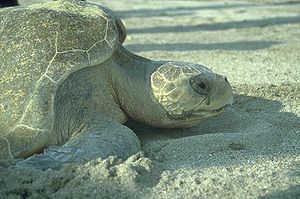
Back غدة ملح Arabic Glàndula de sal Catalan Solná žláza Czech Salzdrüse German Salglando Esperanto Glándula salina (zoología) Spanish غده نمکی Persian Glande à sel French Glándula do sal Galician 염류샘 Korean

The salt gland is an organ for excreting excess salts. It is found in the cartilaginous fishes subclass elasmobranchii (sharks, rays, and skates), seabirds, and some reptiles. Salt glands can be found in the rectum of sharks. Birds and reptiles have salt glands located in or on the skull, usually in the eyes, nose, or mouth. These glands are lobed containing many secretory tubules which radiate outward from the excretory canal at the center. Secretory tubules are lined with a single layer of epithelial cells. The diameter and length of these glands vary depending on the salt uptake of the species.[1]
Salt glands maintain salt balance and allow marine vertebrates to drink seawater.[2] Active transport via sodium–potassium pump, found on the basolateral membrane, moves salt from the blood into the gland, where it is excreted as a concentrated solution.
- ^ Ellis, Richard A.; GOERTEMILLER, CLARENCE C.; STETSON, DAVID L (1982). "Significance of extensive /'leaky/' cell junctions in the avian salt gland". Nature. 268 (5620): 555–556. Bibcode:1977Natur.268..555E. doi:10.1038/268555a0. PMID 887174. S2CID 28638773.
- ^ O’Driscoll, K.J.; Staniels, L.K.; Facey, D.E. "Osmoregulation and Excretion". Archived from the original on 8 July 2007. Retrieved 6 July 2007.